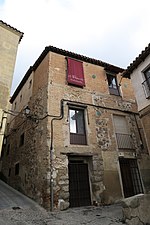Iglesia de los Santos Justo y Pastor, Toledo
13th-century Roman Catholic church buildings in Spain18th-century Roman Catholic church buildings in SpainBien de Interés Cultural landmarks in the City of ToledoMudéjar architecture in Castilla–La ManchaRoman Catholic churches in Toledo, Spain

The Iglesia de los Santos Justo y Pastor, popularly known as Iglesia de San Justo, is a church located in the city of Toledo (Castile-La Mancha, Spain). It was founded after the city was taken by King Alfonso VI of León and Castile in the 13th century. The city underwent transformations between the 14th and 18th centuries. This is a religious temple under the invocation of the holy children Justus and Pastor.
Excerpt from the Wikipedia article Iglesia de los Santos Justo y Pastor, Toledo (License: CC BY-SA 3.0, Authors, Images).Iglesia de los Santos Justo y Pastor, Toledo
Calle San Juan de la Penitencia, Toledo
Geographical coordinates (GPS) Address External links Nearby Places Show on map
Geographical coordinates (GPS)
| Latitude | Longitude |
|---|---|
| N 39.8561 ° | E -4.0215 ° |
Address
Iglesia de los Santos Justo y Pastor
Calle San Juan de la Penitencia
45002 Toledo
Castile-La Mancha, Spain
Open on Google Maps










